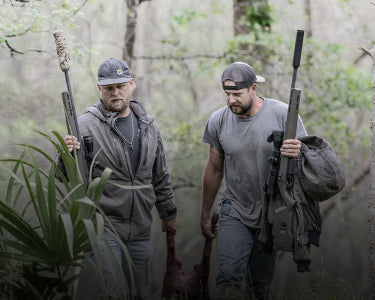The sleek, classic black rifle is great for everyday use. Whether it’s used in the swamps of Louisiana, the snowy mountains of Colorado, or the rocky red deserts of Nevada and Utah, everything goes well with black – but it’s not perfect.
Hunters who find themselves consistently hunting in the prairie or desert may appreciate the value of a rifle in flat dark earth.

In the desert, black is not a naturally occurring color and the darkest things in a natural environment are typically shadows, shaded areas, or depressions. As depicted in the image above, a black rifle stands out much more than even a solid FDE rifle with no camouflage pattern.
While deer, hog, and many other huntable animals don’t see color the way we do, they definitely see shades. Even if an animal had black and white or grayscale vision, a black gun would pop much more than one in FDE.
The acronym stands for Flat Dark Earth. Flat due to its matte non-glossy finish, dark for its shade, and earth for its sand-like color.
Even in the animal kingdom, the vast majority of mammals with black fur are nocturnal. Diurnal animals – especially prey animals, whose entire survival depends on how well they can hide – are usually tawny, tan, or some variant of brown. There are some exceptions of course, but Creation is generally in agreement that black camo is better suited for nighttime use.
We humans, who had relied extensively on camouflage during our time as hunter gatherers, largely ignored it when we began fighting each other. For hundreds of years, bright colors and shining armor were the military status quo until someone realized that bright red coats were a liability when someone was trying to shoot you from a hundred yards away.
Khaki, the direct ancestor of FDE was one of the first “patterns” to be introduced to units in the British Army on a wide scale. 19th century British troops fighting in the sandy wastes of Southern Asia noticed their Indian sepoy auxiliaries purposely staining their light cotton uniforms with sand or tea to blend with their surroundings. It didn’t take long for the entire army to adopt khaki as an official uniform color.

American troops soon adopted the color for their campaign uniforms in Cuba and the Philippines. Although their blue woolen shirts negated whatever camouflage their khaki pants and hats provided in the jungles of Southeast Asia, US armed forces soon adopted it on a wider scale during World War I.
Naturally, other militaries around the world soon followed the muted color trend, and by World War 2, every major military in the world had done away with their colorful coats and adopted either khaki, olive drab, or gray for their field uniforms. Rifles were yet to follow suit.
Decades after the world wars, somewhere in the Rhodesian bush, someone decided it would be a good idea to paint his rifle with leftover aircraft paint to blend better with the grass and shrubs of the savannah. The Rhodesian Army was fighting an irregular war against separatist forces, where ambushes were more common than conventional warfare. Stealth and subterfuge were the order of the day. FALs and G3s were painted in a green and yellow camo scheme frequently described as “baby poop.” While it looked atrocious (hence the name), it proved to be effective in the dry savanna.

In 1984, four years after the Bush War ended, a company was founded in southern Oregon that would change the world of rifle camouflage forever. Cerakote, a company which started out coating car parts, would soon expand into the firearms industry, but not before two marine snipers would put their heads together to figure out what kind of uniform their brothers in the Corps would wear.
USMC sniper Sergeant Ken Henley was tasked with helping the Marines develop a new camo to replace the M81 woodland pattern. Not only was it the same pattern the army was using, but it also had too much black and green to be of any practical use in the desert. Initially, the Marines were deciding on a pattern very similar to what the Rhodesians used during the Bush War, but Henley’s partner, another sniper known only as “Gunny H,” stumbled upon a nice flat, dark, earthen color in the paint section of a Home Depot. It was a Ralph Lauren paint with the color code SF11B. This “Coyote” brown had just the right saturation to make it mesh well with either olive drab or tan and went on to become one of the main colors in the Marines’ digital MARPAT camo.

Coyote brown serves as the base color for the woodland MARPAT camo pattern.
When the United States went to war against terrorists worldwide, the military anticipated that most of the fighting would occur in the middle east. The green of the Vietnam War and the Cold War era made way for khaki, coyote brown, and flat dark earth.
As went the military, so went the civilian world. The proliferation of flat dark earth accessories like boots, chest rigs, backpacks, and clothing carried over to the world of firearms. Soon, painting weapons was back in fashion again, and this time Cerakote was available to make sure the finishes looked nice and professional. Flat dark earth was one of the most popular coats for firearms in the late 2010s and remains so to this day.
Weapon accessory makers also caught on to this trend, with brands like Sightmark producing reflex sights like the Mini Shot and the Ultra Shot as well as powerful red dots like the Wolverine coated in flat dark earth to match customers’ rifles. Sightmark knows that, just like the Americans with their blue jackets and khaki pants at the turn of the 20th century, too much black can negate the benefits of good camo.




